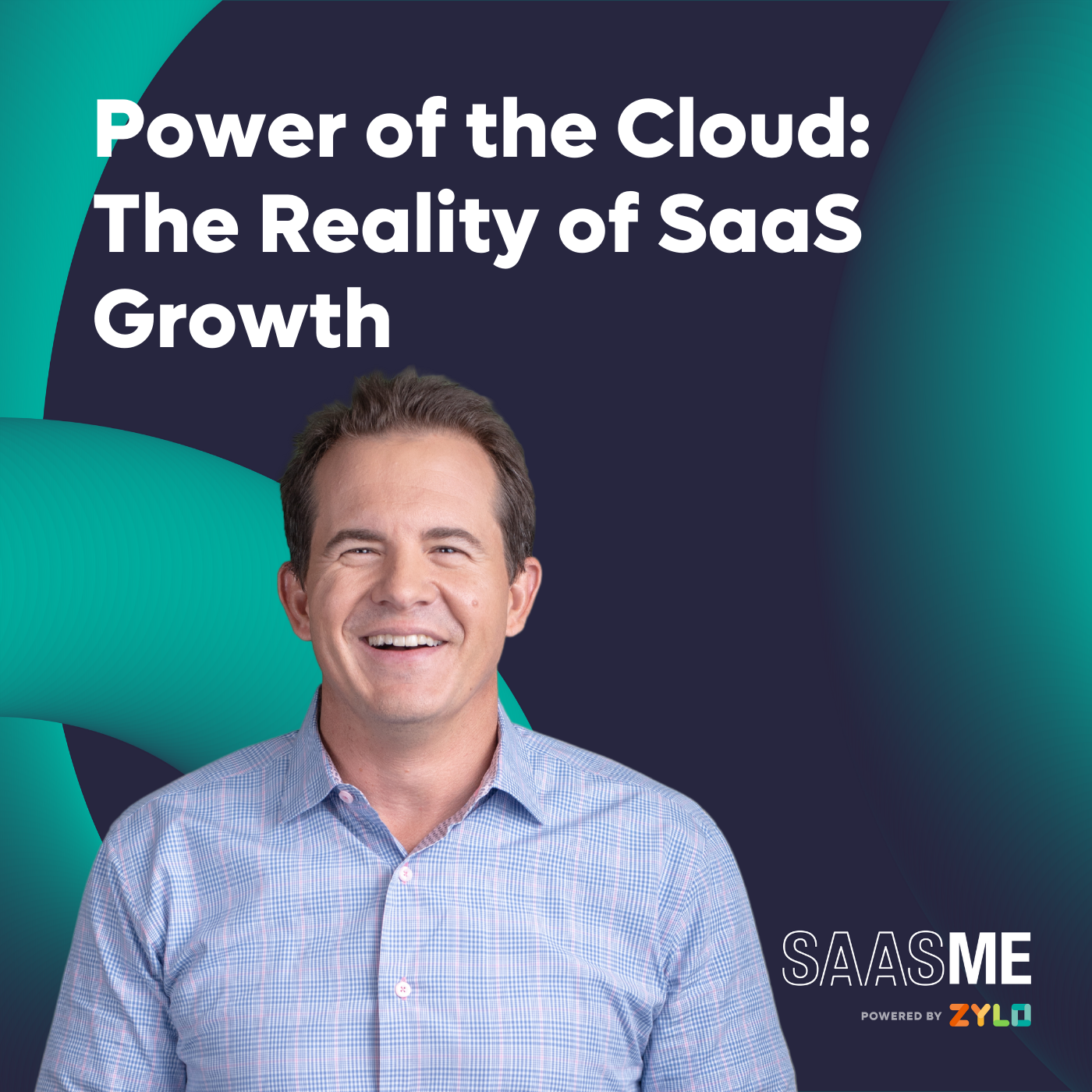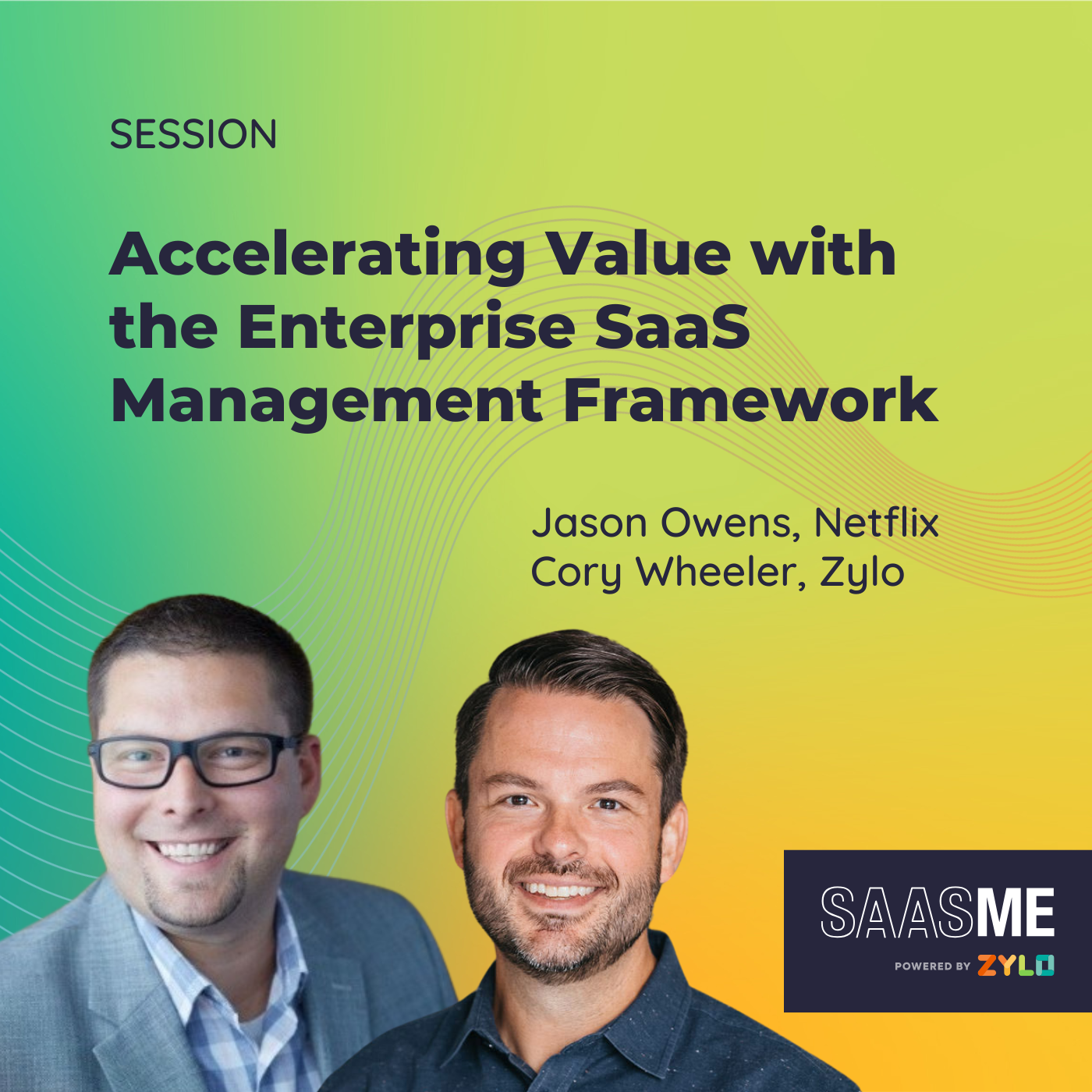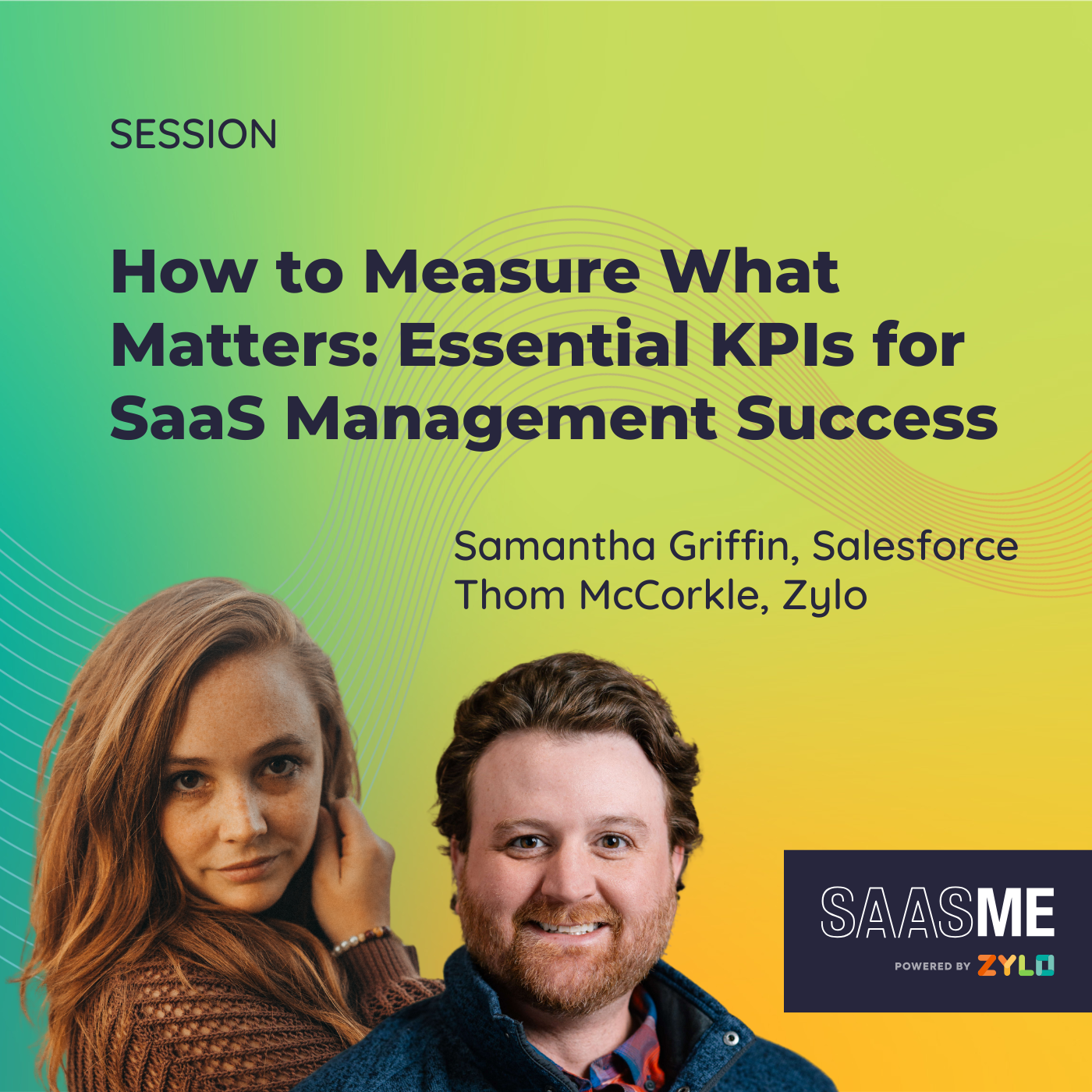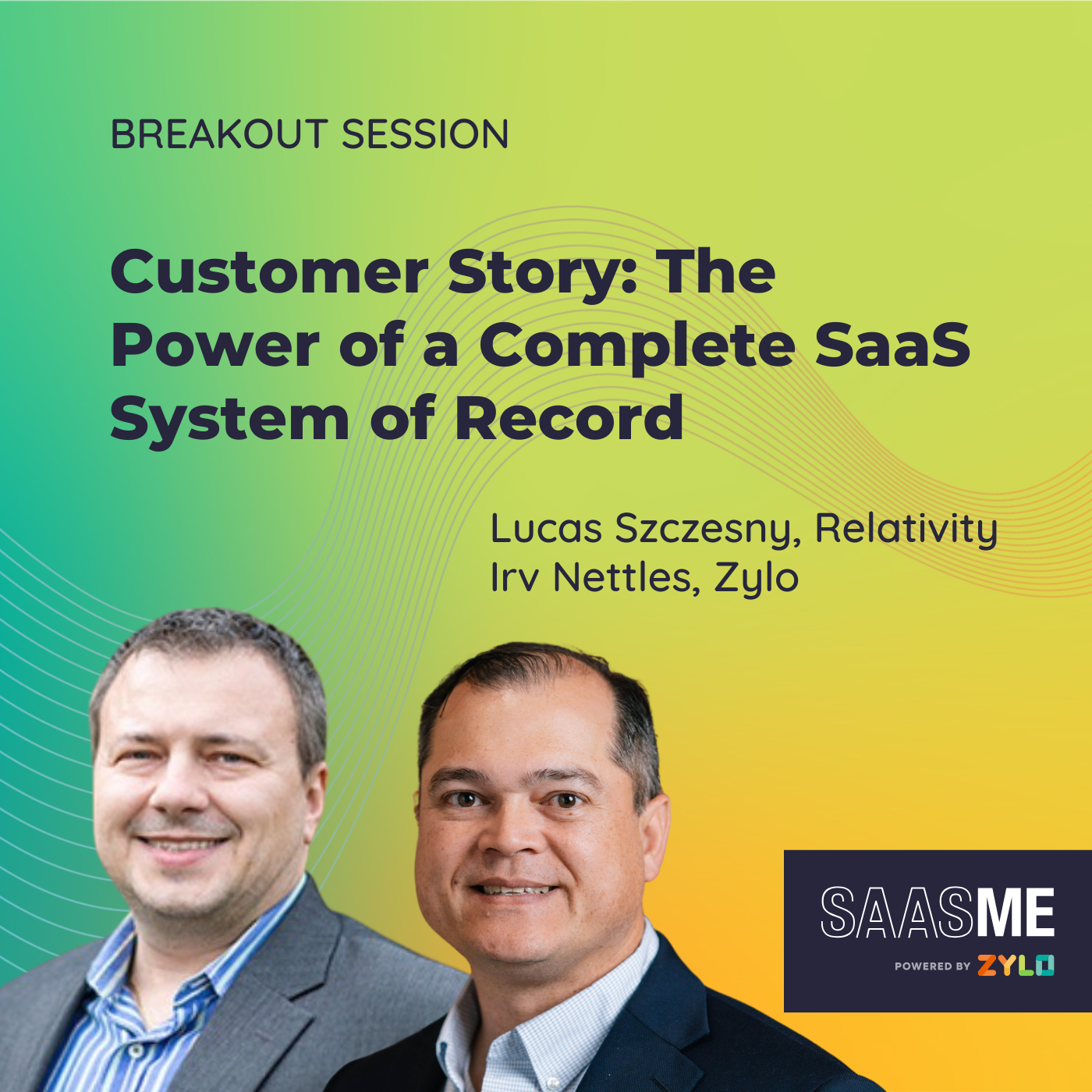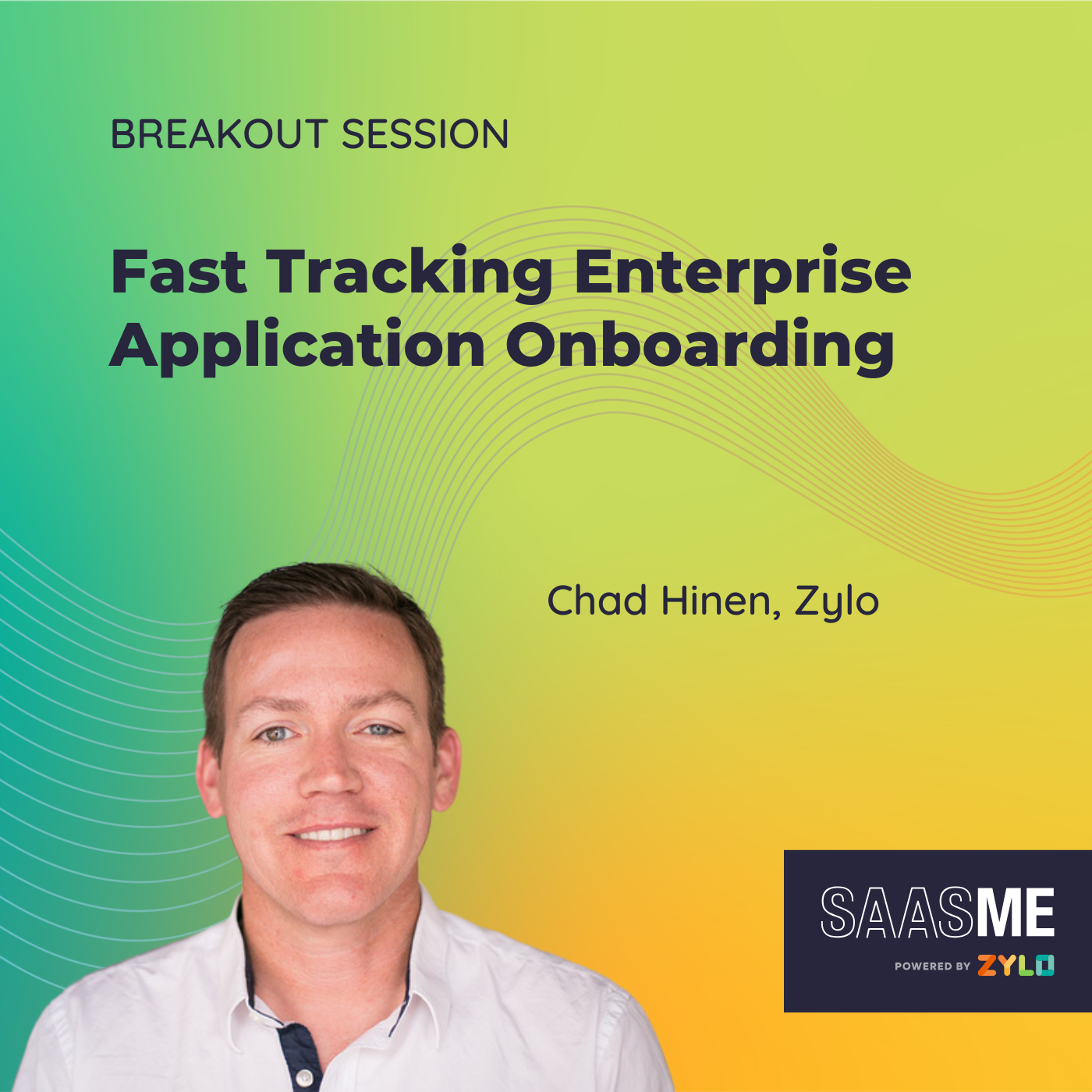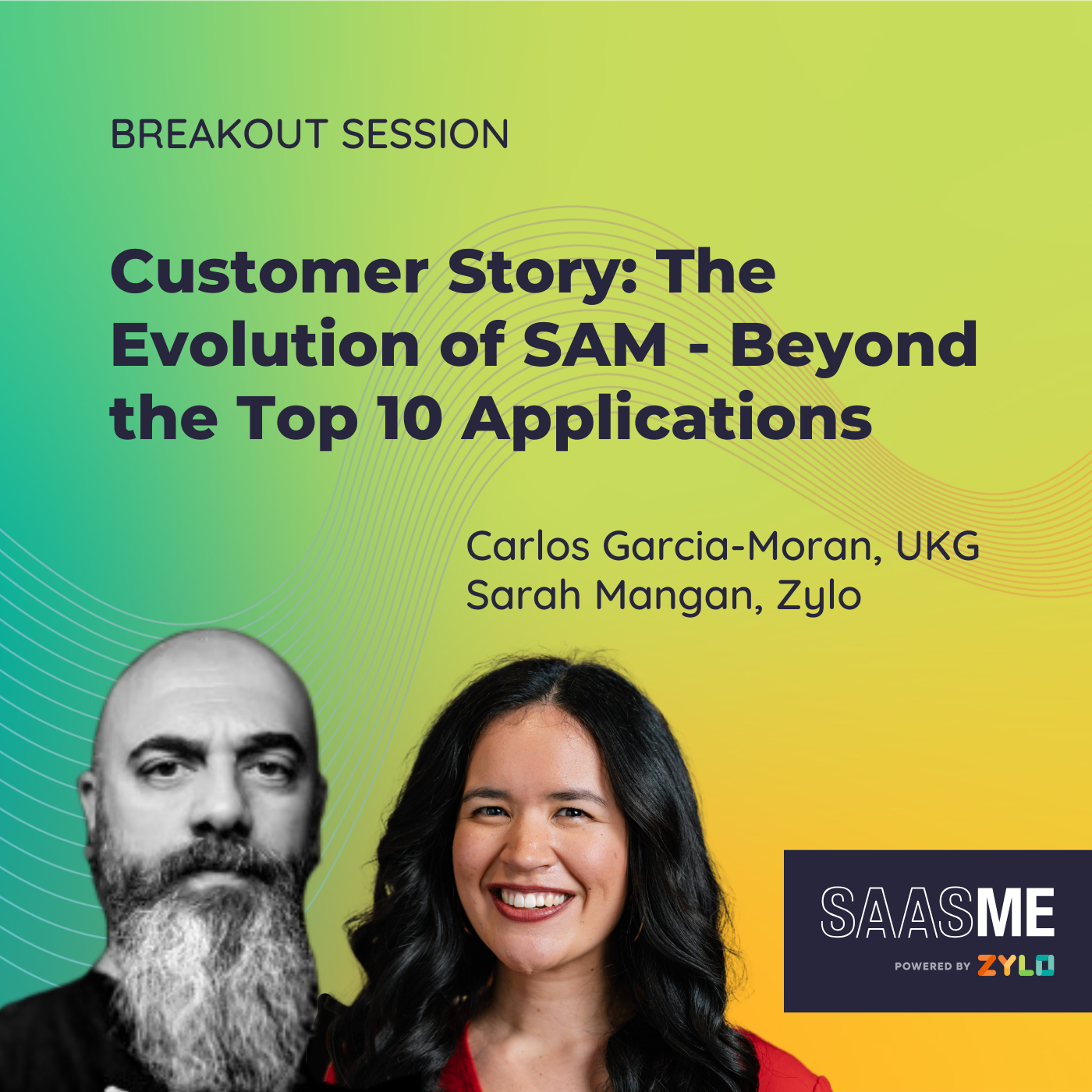Power of the Cloud: The Reality of SaaS Growth
- 0.5
- 1
- 1.25
- 1.5
- 1.75
- 2
Eric: So I'm excited to pass it over to Byron, who's going to jump on here and he's going to start his session here shortly on the power of the cloud, the reality of SaaS growth. Byron, welcome to SaaS Meet 21, and so excited to have you, thank you for your time. And everyone, I will see you throughout the entire day and we'll close out with you. So I'm excited to participate with all of you. So have a great day, enjoy the content, interact and let's have a lot of fun. Thanks.
Byron: Cheers. Thank you, Eric. Good morning. Good afternoon. Good evening to all of you teleporting in here from different time zones. And I am absolutely thrilled to be here with you, for many reasons. I look at this group as the master's class in cloud. Each of you have been in this world and know this world intimately, and we're in the middle of a revolution. And so the chance to talk with you, share learnings and have a discussion for me is a lot of the fun of this role in this industry. I'm going to pull up some slides, which I'll share with you to drive the conversation a little bit, but as Eric said, my hope is that we can use this as a fairly interactive time. And I would love it if you would light up the chat as we're going, feel free to steer me with questions, comments, et cetera. And from my perspective, that makes it a lot more fun. And I will, at the end, allow some time to dive into the questions in a more complete way, but as we're going, feel free to add comments, et cetera, and I'll try to get to them or weave them in even as we're talking.
Byron: And so by way of set up before diving into the materials, let me just say that a lot of our enthusiasm for working with Zylo came from the belief that SaaS was reaching this tipping point, and that the industry growth was so significant that the management of SaaS and the advantages of SaaS were going to require experts to unlock that organizationally. And that meant people, processes, and systems to really take advantage of this great technological wave.
Byron: And now as a firm at Bessemer Venture Partners, we've had the privilege of working with more leading SaaS companies than any other venture firm in the planet. We've been responsible for about one in three of the cloud IPOs, including many of the greats out there, like a Shopify, a Twilio, DocuSign, Toast a few weeks ago, LinkedIn and dozens of others. And having seen this first hand going back now over 20 years, both as investors and in many cases as operators. Myself, I was a founder and CEO of a SaaS business myself over 10 years ago. And we have seen first hand what's happening in this market, the power of this transformation, the opportunity and some of the challenges. And we're going to try to go through all of those today.
Byron: The overview of this talk is really based on something that we do each year called State of the Cloud. And as Eric had mentioned, we tend to release that each year at SaaStr at their annual conference, and then do an update throughout the year. This you can think of as kind of a special version for the Zylo audience. Given your level of expertise, we've pulled some slides that we think will be particularly informative for this group. And what I'm going to attempt to do is talk about where the industry's come from and give just a synthesis of what the last decade plus has meant. Where we're at now, what's happening with this record setting year we're in the middle of, and then a little bit of where we're headed and we'll end with some predictions of where I and we at Bessemer believe this industry is going and how that may impact you in the years ahead.
Byron: But let's start with a little reflection. And this goes back to February of 2020, when we gave the State of the Cloud update just 18 months ago. This was as the world was going into the pandemic and we had just crossed a massive and major milestone for the industry. At Besemer we work with NASDAQ and WisdomTree to manage a basket of public stocks called the Bessemer NASDAQ Emerging Cloud Index. That is the 58 pure play public cloud stocks that represent the cloud industry. And that includes everyone from Salesforce and Adobe on down. A milestone was reached that February, literally within days, coincidentally, of when we revealed our 2020 report, in that the industry crossed$ 1 trillion of pure play market cap. Now mind you, that doesn't even include the market cap of the cloud businesses within hybrid companies like Microsoft, Google and Amazon, which certainly make up additional trillions now today. But from that milestone mark, one of the things we predicted was that we had line of sight to crossing$ 2 trillion in the coming years. That the cloud momentum was real, it had undergone over a 35% annual growth rate in the proceeding five years, and we were projecting forward to see that happen in the coming years. Now we're essentially, and our bullishness on cloud is well documented. Let me say it that way. As one of the largest shareholders of cloud assets in the entire industry, we've been long believers in the momentum and the potential for cloud, and yet even we underestimated how massive and how significant the coming years were going to be.
Byron: When you roll forward to the update that we did just a year later in our 2021 State of the Cloud, we had over doubled. Part of this was the COVID tailwind, which we'll talk about in a minute. And part of this was the additional wave of IPOs that had come into the space, and then this massive organic growth rate that had continued to evolve over those 12 and 13 months. You roll forward to today, we're about to pass another milestone of 3 trillion as we sit just under that milestone at$2. 9 trillion for combined cloud market cap. And if you step back and think about this over the last eight years, and you look at this index performance, it is up 12X, you know, the proverbial dollar in cloud would've yielded you$ 12 just eight years later, to show this is what the basket post IPO of the leaders have done and just how amazing this trend has been. And if we think just over the COVID time, one of the software leaders, Satya inaudible, and Microsoft I think said it very well.
Byron: The COVID acceleration that happened in March to the summer of last year was really this amazing pull forward and this rapid digitization. That showed it's really hard to support on prem software if you're not on prem. And that the power of collaboration and access and modernization of cloud tools is really taking hold. And so oftentimes we get asked, is this a one time bump or what happens post pandemic? I think the answer there is very, very clear. People have seen a better way. People understand what is possible with SaaS apps and cloud infrastructure and the technologies, the intersection between mobile and web apps, and people aren't giving that up. In fact, now that many of your organizations have rushed to deploy quick solutions for departments and give people access to critical systems, much of the next few years is going to be rolling that out to other teams and doing some rationalization and optimization of those solutions to make sure that they're a permanent part of the organizational fabric. And that's very much what we see on the horizon for the coming years.
Byron: Another trend that we've observed is this transition. People talk often about the FANG basket. The Netflix and Facebook and Apple and Amazon and Google phenomenon of really the internet and mobile trends of the last decade. One of the things that we've gone on record in saying that we launched this on CNBC and continue to reiterate what we see as the separation is that trend has largely run its course. And that, of course, there's still growth ahead in internet and mobile, but the next great wave in technology is cloud. And so what we did is coined a basket that we call Mount SaaS, which is Microsoft, Twilio, Salesforce, Amazon, Adobe and Shopify. And that is the new cloud leaders and the next great basket of technology stocks. And as you see over the multi- year five year window, this basket has massively outperformed the Dow Jones, the S& P 500 and FANG itself. And then you look over the last year and a half, and you see this sustained outperformance. And this is really what we think of at the high level before we go into the companies and individual names and the trends you're seeing within your businesses. But we see this at the highest levels now at the basket of pure play public cloud stocks, at this Mount SaaS overtaking FANG phenomenon, and then certainly at the individual company level as you see this mountain of cloud building and really the next great pillar of technology starting to take hold.
Byron: Now, if you look below the publics, the next place to look is privates. And I'm sure most or all of you have heard this term unicorn, which used to be the unimaginable. It was this idea that there was a private company worth over a billion dollars. Now, we also work with Forbes magazine each year to manage the private top 100 list of cloud companies worldwide and have done this for many years. And if you go back and look at the history of cloud companies and private companies worth over billion dollars, the very first one was the Bessemer portfolio company in 2008, LinkedIn, which ultimately sold to Microsoft for 26 billion. And through the years you saw that a few were created and the trends started to build, but then you fast forward to what happened in the last several years, and specifically what's happened in the last year, and you see this huge leap forward where you have now almost a doubling year over year to 150 plus unicorns in the cloud space. So much so that when we started thinking about the top 100 list, there wasn't a single cloud unicorn on the list. And now today, when we fast forward, the entire list is made up of unicorns. And there's another 50 companies we couldn't include on the top 100 because the list was too long. And so that's the state of the private industry today. And in total, you have across all of tech now over 800. Within the cloud 100 specifically, there's another half trillion dollars in market cap captured within that basket that will go public in the coming years. And the top 10 names alone are household companies that I'm sure your businesses are already using and starting to embrace, ranging from Stripe in payments to Databricks and HashiCorp and infrastructure companies like Canada for the creative professionals and marketing teams, and then vertical solutions like ServiceTitan that are taking hold and helping to bring world class technology to entire vertical segments. And so this decade, and then this year specifically that we're all part of is one that we believe we in tech will look back on as one of those transition points. And literally one of those years that a decade from now, we're going to look back and say it's amazing that we were part of this, and it's amazing what we saw firsthand. And here's why. IPOs, we're already over a hundred in venture backed tech alone. And we're going to set an all time record this year that will eclipse even 2000 back in the dotcom era in terms of new technology offerings. In terms of venture capital dollars, same thing. We are well on pace to set a new record in terms of venture financings that will eclipse anything we've seen, including going back to the dotcom era. And then when you look at it for tech exits, M& A and IPOs, as well as M& A transactions and venture backed M& A transactions, records across the book. And then the other thing that we look at in the venture capital industry specifically, is there's also a record amount of dry powders still sitting there, meaning funds that have been raised, but not yet deployed, which is the leading indicator for future startup activity. And that suggests that the wave of tech still ahead is even more significant. And here's why. What we're seeing is the rate and pace of innovation has been accelerating. My first IPO as an investor many years ago, was Cornerstone OnDemand, an early cloud company in the HR tech space that many of you probably know of. It took them 13 years to go from one to a hundred million in ARR, very steady progression, very successful at the time, a multi- billion dollar public company ultimately. You roll that forward, and if you put a time scale against these companies, and I'm proud to say these are all Bessemer companies, since we know them well, and we're able to use their data, you see this acceleration where more and more companies are reaching that milestone in 4, 5, 6 and 7 years. And then even more startling is that we're starting to see companies go from a hundred million to a billion of ARR in a faster time period. Canva, a Bessemer investment just announced that they are on track to pass a billion dollar milestone later this year, which will be just three years from when they cross the hundred million mark. And so you see this staggering rate and pace of activity and adoption, and that to us shows what's ahead in terms of the future and the potential.
Byron: And before we go into predictions, I'm going to zoom out here just real quickly to see if there is anything from the chat side. Okay. You're going easy on me so far. So I'm going to keep the chat box up. And then what I'll do is I'll go through the predictions here a little bit, and then I'm going to flip it over to the group and save a few minutes so that if there are direct questions, please type them directly into the chat and we'll dive into those. But let me go back to presentation mode here, as I think this will render a little better for you at home. There we go. Okay.
Byron: So the last section before opening up to questions is where we're headed. And what we like to do each year is call out our shots a little bit. And actually in prior years, we have scored ourselves against these and said this is what played out rapidly, and this is what we've missed. And so I'll commit to doing that at some point publicly on these predictions as well. But let me walk you through what we see first hand.
Byron: We're going to talk about seven areas and we're going to go deep into each of these. And these represent where we think the next wave of innovation at the early stages will be. And so these are the things that you're going to see coming across your SaaS management desk or where you're going to see probably the most innovation coming towards you in your professional context.
Byron: One of the first areas we'll talk about is this unbundling of the office. And this is very much you can think of literally as the Office Suite in the Microsoft context, as well as your physical and virtual offices across various companies. And sorry for the formatting, but emails and messaging as you see, finally technology coming to bear to help allow some AI support to decisioning and responses and filtering for the steady flood of the inbox overload that we all deal with. We're seeing this across collaborative virtual rooms, project management, certainly the world of calendaring and collaboration and events. More and more of this is starting to take place where specialty products are coming to bear, where they can integrate with and support your existing tools, but do it in a modern cloud enabled world. And we believe that these types of applications are going to find their way into businesses. And for entrepreneurs out there that are watching as well, these will be many of the new areas to drive innovation.
Byron: So the second is SMB. And what... Oh, great. And we've got some questions coming in. I'll weave those in here to some of the answers. What we finally started to see is that cloud distribution and the internet unlocks the customer acquisition cost barrier that traditionally burdened software distribution to small and medium businesses. It was very hard to take a direct enterprise selling approach to go to market with low price point software in traditional chance. However, with direct customer acquisition, with online marketing, with the ability to do demand gen and product led growth strategies, we're seeing a reversal, and finally you get this great unlock that great software can reach small and medium businesses. And so for many of you out there that may be executives in smaller companies or perhaps vendors that are selling to smaller companies, this is representative of the tailwind that you're all benefiting from right now, and it's happening across vertical segments. Certainly the functional verticals that are representative here across the top, as well as some of the foundational areas within IT and ops, and even more interestingly as represented by the Toast IPO in the restaurant industry a couple weeks ago, which was the largest software vertical IPO in history, as well as companies like ServiceTitan for field automation, that's shared their valuation in the$ 10 billion range. You've got Squire for the hair salon industry and Shopmonkey for automotive, Glass Genius for the salon industry and Brightwheel for education. And since a number of these companies are starting to deliver great technology for verticals, and that now is at this tipping point, whether it's Shopify at 200 billion or Toast at 30 billion on down, that vertical software is finally able to reach scale and get into the hands of the SMB buyers.
Byron: The third prediction has to do with a fundamental and overdue social trend that is also now becoming part of a corporate context and corporate platforming. And that's the tools and technology to support a lot of the D, E and I efforts within businesses and organizations. And as is often the case, people talk about you need to track what you want to improve. And so this starts really with the tracking and talent management side. Companies like Synio that are helping with pay equity for large enterprises. Companies like Culture Amp that are doing surveys on diversity and things to help understand where there may be pockets of different views and opportunities for improvement within organizations.
Byron: And then you get in the training and education, sorry for the typo there, reporting and recruiting aspects that all suggest the power of products to help your businesses go through this transformation. And we're seeing immense innovation here with a number of net new companies being created to help give technology companies and broader businesses the tools to make these improvements within their organization. On the data and machine learning side, we've heard about these trends for years, where we hear people talk about AI and the potential to unlock. But you haven't seen a lot of it come through in terms of business environments. That's starting to change. We're starting to see a lot of foundational data science and infrastructure categories emerge, as well as the monitoring and visualization layers that will start to touch the end users. And we're also seeing these technologies and tools find their way into applications so that more and more of the tech stack will help with decisioning and help save time for the business user, which is one of the fundamental promises of AI that is just starting to take hold.
Byron: Prediction five has to do with really the creator economy and this idea of the citizen developer. And this is both at the individual tech stack layer where this is the technologist that wants the ability to integrate systems with a Zapier, or to be able to use rapidly stand up web pages and analytical tables with Airtable, or use tools within that, as well as the creative professionals such as the marketing teams that are using Canva tools in a modern wave to leapfrog the Adobe tool stack. And many of the teachers and the creators out there with content that they can now have democratized access to tech end to end users in a very different way. And then two to go.
Byron: This is one that you've probably heard an immense amount about, maybe too much from some of your perspective is the crypto trend, but I want to split that out from what we see also within fintech, which is that more and more tech products are embracing fintech capabilities, and whether that's the Stripe type layer for payments directly, or if that's a company like I mentioned Toast before in the restaurant industry that also integrates payments directly into it, as well as a lot of the security related elements there with the identity and fraud prevention and tech stack pieces, certainly the modern banking and the unbundling of the banking industry itself and the banking as a service and the B2B and B2C lending practices. Enabling technologies for high net worth broker management, wealth management, as well as broad AI tools for portfolio management, the betterments of the world. And then certainly crypto itself is an entire category, but there is an enterprise and a cloud layer of crypto for management and the potential there.
Byron: And then the last one goes back to the SMB comments, that technology can reach SMB. And one of those segments was vertical SaaS. And this is the idea that industry also represents its own opportunity, specifically as that wave becomes more of a tsunami and we see across just about every conceivable industry segment a purpose built company that is right there for that industry, ranging from education to banking and auto repair. Really what we're seeing in that market is utterly inspiring and changing the face of the late stage IPO waves. And for those of you out there in verticals, both functional verticals and industry verticals, the depth of tech tools available for you, it has gone up 10X in the last five years, and the trends there will continue. And so I'm going to use that as a dropping point to dive into the chat here and I will stop the share so that the proportions here are a little more equalized.
Byron: And let me start with the question from Frank here, which is what are the fastest growing categories of SaaS and how has that changed just over the last year? I'll tell you mathematically in our cloud 100 list, the fastest single categories were fintech and data infrastructure, and the two drivers there, for fintech that was very much crypto powered, but also payments aligned, you hear a lot about the neobanks and the potential to take these massive fin serve industries and deconstruct them in a way that's more accessible, that's more nimble and that's integrable into products and services, and we're seeing that more and more. And then on the infrastructure side, we are absolutely going to see this potential of infrastructure as a service and platform as a service supercharge app development, and a number of the most promising IPOs that inaudible are waiting for include companies like Databricks and HashiCorp, where they're already sitting at tens of billions of dollars of market cap in the private sector and waiting to make that tipping point over into the public world.
Byron: Okay. What opportunities are you seeing in privacy and online data given the distrust of big tech? So several discussion points there, and frankly we could talk for a whole other webinar on that, but let me give a few high level points. The first is on data privacy fundamentally. And for many of you in the SaaS management world, this will be a steady question and an opportunity both for vendor evaluations, as well as for management. And this goes into security, which is to say that fundamentally it's been pretty proven at this point that dedicated purpose built products with known defense vectors against attacks are more secure than IT teams trying to run hundreds or mathematically actually thousands of applications often within data centers with open- ended attack planes and without knowing them as intimately. And so the security side of cloud has held up remarkably well and is showing time and time again better than custom apps or onprem apps. However, the crooks keep innovating, and this will be a never ending battle. And so there's the security side of this and then there's the data privacy side of this, which is that companies are more and more now thinking about data residency and geo residency. As countries are imposing restrictions that you have to leave certain elements of data here, you have to do certain encryption standards for different data elements, and then oftentimes they're even choosing to not hold the data at rest, given the exposure. And that's a constant vector of discussion within our companies. And that will be a steady push. I would also say that Washington is certainly pushing on big tech right now, which will have several unintended consequences, which could also put a real freezing effect on the M& A landscape and potentially by extension some of the funding landscape. But we do believe that will settle ultimately in a rational way.
Byron: There's a question here about the tech stack and the benefit from the shift towards Data Mesh. And I think this really is an extension of the data stack overall. And it's this idea, well there's an old saying, let me start with this, that if you're trying to create great decisioning software, would you choose great algorithms or great data sets? And the computer scientists out there will tell you, I'd take a B algorithm with an A dataset over the reverse any day. Just the ability to train and learn is so powerful. And so as you get these data lakes and as you get these infrastructure layers that go over the top, the ability for corporations to make better decisions and to access that data to help do predictive things and to actually get inside the inner workings of your business are immensely powerful. That was part of the premise behind the Snowflake IPO last year, which was the largest software IPO in history, because of what they're doing to unlock this data, give companies access to that data and then build upon it. And we see that continuing, including at the visualization layer, and as the apps really embracing that. I'll repeat the Mount SaaS names. Thank you, Isaac/ Microsoft, Twilio, Salesforce, Amazon, Adobe and Shopify.
Byron: And then let's see, largest pain points now for discovering, evaluating, onboarding the right SaaS tools. That's a perfect setup question for many of the panels that Zylo set up for later in the day. What I would say is that the best products are finally winning. And that to me is a great thing, where you can do so much online discovery and evaluation, and then you can do benchmarking. And then with partners like Zylo, you can actually figure out the right pricing and licensing and management of that. Finally great sales reps aren't winning great products are, and that to me is a great sign for this industry and where we're headed and many more discussions are coming there. Oh yes. Do I see the SaaS players uprooting the legacy companies like Oracle and SAP? Thank you, Taylor. And absolutely. The legacy vendors have been caught flat footed by cloud. And this goes back many years where Larry Ellison called it water vapor and SAP actively sold against it for years. Their business was under attack and they believed that they could defer or diminish cloud and very actively tried to do so. And the reality is cloud will become a majority of all software over the next three years. The trend line is clear, the passing is happening, and those companies are now scrambling to make up for those past strategic errors. They're doing that by acquisition. They've both made very large and sizeable acquisitions. Many of them have been smart buys to get in. And so they're certainly relevant and they're building out their cloud platforms and they're cloud washing their storylines and their marketing. But the best of breed are winning here. The pure plays that are purpose built, cloud native, cloud first are winning. And the old lock- in that you used to have from these suites, and you used to have to buy everything in SAP because they work together well, well, the internet is the new middleware, and open APIs are the new integration fabric. And so you can now buy the best tech product for each functional need and each end user and they'll work together. And so you don't need the suite vendor really driving that, and that's a massive unlock area.
Byron: And then I'll answer this last question before handing it over to Eric, which is really thoughts on SaaS companies focused on IT span management. Category specific like Zylo SaaS management or general spend management like Coupa. Thank you Gary for that. And so this is I think this next great progression of the cloud category, which is we had to get to critical mass where we could have really the complexity and the scale, and frankly the percentage of your IT budgets had to grow to a point where this inaudible. We're well past that, as you just saw. Trillions of dollars of value in this industry. When we look at when Zylo runs their surveys within your org, for those of you that have taken them up on that pilot effort and the sales process, I'm sure you're all shocked how many tech tools are within your organization. We are when we see it time and time again, how many tools have found their way into your org. And so Coupa's a great company on spend management and they very much are across the broader enterprise. And then the primary reason why we became investors and partners with Zylo is we believe they're going to do this for the spend management category of SaaS. They're clearly the product leader today. We love the team and they're well on the way, working closely with partners and customers like those on the call today to define this category together. And so we hope this becomes the next great software category like Shopify and Zoom and DocuSign and Twilio and many that we've worked with before. And we're excited to be on this journey with all of you.
DESCRIPTION
SaaS growth is skyrocketing as we witness historically high rates of digital transformation. Join Cloud luminary and originator of the Cloud 100 Byron Deeter as he shares why SaaS is the future of software and a business imperative for companies to stay relevant today and competitive for years to come.

